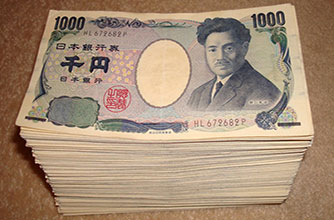Source: Fxprimus Forex Broker (Review and Forex Rebates Up to 85%)
The yen has been falling for some time. On a PPP basis, it’s now seriously undervalued – averaging out its PPP valuation calculated using consumer prices, producer prices and the OECD methodology of looking at a basket of goods, it’s the most undervalued of all the G10 currencies. Can it really fall any lower?
Yes, in my view. The currency was seriously overvalued for years and I see no problem in it being seriously undervalued for years, too. The point is that growth is structurally slow in Japan and so I expect investment funds to move elsewhere in search of higher returns, causing the yen to weaken.
We can see that trend already when looking at the basic balance (the current account plus long-term investment: portfolio investment and foreign direct investment). Over the longer term, the basic balance is a good indicator of which direction the currency is headed. As you can see from the graph below, it’s a large outflow from Japan.
Portfolio outflows continue unabated as investors seek higher bond and equity returns abroad. Three-quarters of the portfolio outflows go into foreign bonds, most of which is likely to flow to the US, where yields are higher than in Japan, rather than Europe, where yields are just as low if not lower. At the same time, the direct investment outflow is only likely to grow. The Japanese population is shrinking, so companies looking for growth will have to increase their operations abroad.
It’s true that the current account surplus is rising once again, but that’s not necessarily a good thing. It’s rising because Japanese imports are falling, not because exports are rising. On the contrary, exports are continuing to fall, but just not as rapidly as imports.
The reason imports are falling is simple: oil prices are falling. That accounts for more than all of the decline in imports.
The authorities were hesitant to allow the yen to weaken further before, because high oil prices in yen terms were becoming a burden for the country. But with oil prices now much lower, they may be willing to countenance a weaker yen to boost flagging exports and support Japanese industry. With the country going in and out of recession, Japan needs the boost to its exports to keep up demand. As the graph below shows, net exports have barely made any contribution to growth over the last several years.
Against this background of domestic demand held back by structural demographic changes, I expect the Bank of Japan will have to do its part to get the Japanese economy moving again.
Furthermore, the BoJ hasn’t met its inflation target by any means. While core inflation (excluding food & energy) has been moving up slightly recently, headline inflation is back to zero.
To make matters worse, people are starting to lose faith in the BoJ. The percent of people who expect prices to be higher a year from now began to rise before PM Abe was first elected as they expected him to put pressure on the BoJ to ease policy further. Mr. Kuroda’s appointment and the beginning of QQE brought a lot of confidence that deflation was finally going to end. But that confidence has started to wane as years of buying bonds has failed to rekindle inflation.
Faced with a stagnating economy and continued deflation, the Bank of Japan will probably have to respond by increasing yet again its QQE program -this time perhaps by lowering interest rates below zero, as several European countries have done already. Negative interest rates have a more direct impact on the currency than bond purchases do. I expect that move would only encourage further capital outflows.
In sum, as the Japanese population shrinks and the economy stagnates, I expect capital outflows to accelerate as investors and manufacturers both look abroad for higher growth opportunities. The BoJ is likely to play its part in this as it loosens policy further to get the country out of deflation, with the inevitable spillover effects onto the yen. I see the yen weakening further in 2016.
Categories :
Tags : binary options demo account forex bonus without deposit Forex Broker forex broker bonus forex learn forex learning forex learning pdf forex tutorials for beginners pdf how to trade forex for beginners pdf learning forex trading pdf Yen Yen Analysis Yen News





